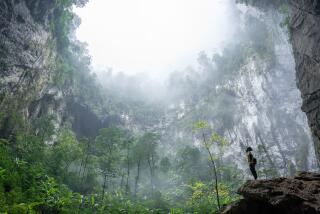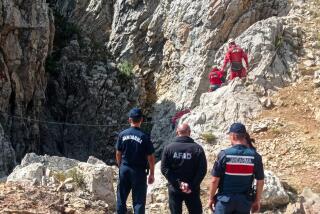Trekking to a Holy Cave in the Himalayas of Kashmir
- Share via
KASHMIR, India — “Jai Shiva Shankar!” cried the excited little man as he bounded down the rocky slope. His frenzied air and religious jubilation were obvious in his movements and words.
Panting from our climb over Mahagunas Pass (14,800 feet), we could only faintly respond, “Jai Shiva Shankar.” Whereupon he turned and continued his hurried descent, repeating to all the same Hindi phrase, “Jai Shiva Shankar.”
We were on a three-day trek to a remote cave in the Himalayan Mountains of Kashmir, India. Sacred to Hindus for more than 2,000 years, the object of the Amarnath Cave yatra or pilgrimage is the ice phallus or lingam of Lord Shiva, all-powerful “Destroyer of the Universe.”
According to legend, Shiva and his consort, Parvati, lived in this cave after their marriage. There the god told his bride the secret of creation. A pair of mating doves eavesdropped on the conversation.
Eternal Rebirth
Having learned the secret, the doves are reborn again and again, making the cave their eternal home. According to our guide we might see these doves, if Shiva was especially pleased by our visit.
The legend continues with Shiva’s decree that his followers should worship his creative force, his lingam, in the form of a large ice stalagmite. This formation grows each summer in the cave by the light of the August moon.
The lingam grows to varying sizes each year from the melting of glacial ice in the cave. Many thousands of devotees flock from throughout India to receive darshan (intense spiritual blessing) from this symbol.
Throughout July and August many people move slowly to the cave that is now a holy place. From Pahalgam the trek can be done in stages over three days and nights.
An alternate route from Baltal can be covered in a single day, but the grade is constantly upward and more taxing. Ponies can be used on either route and there is regular bus service from Srinagar to Baltal.
Leaving the opulence of a houseboat on Lake Dal in the Vale of Kashmir and traveling by Jeep to the alpine beauty of Pahalgam (elevation: 7,000 feet), we began the walk up a long forested trail to Chandanwari (9,200 feet), the start of the pilgrimage.
Tent Hotels Set Up
Although our party had deliberately selected a time more than two weeks before the height of the yatra, the trail was already filled with Kashmiri Muslims setting up tea stalls and tent hotels for the seasonal crowd.
Well-dressed Brahmins with smug smiles passed us in Jeeps. Entire families trudged along with supplies on their backs.
Everywhere we saw sadhus-- Hindu holy men with dreadlock curls, painted faces, outrageously colored hair and beards, near-naked bodies and wide-eyed looks.
Because this pilgrimage draws such large numbers, campgrounds where one can stop overnight are designated by the Indian government. Our guide oversaw our arrangements and our cook prepared various meals of rice, lamb, vegetables and curry.
The mountains are high and cool and the sound of rushing water in Chandanwari lulled us to sleep.
The withering heat of the Indian lowlands seemed a million miles away as we began a chilly, early-morning start to Sheshnag Lake at 12,230 feet.
“Please see that your arrangements are perfect” is the first item on the list of “Instructions for the Yatries” in the “Shri Amar Nath Ji Guide.” It is an instruction worth heeding.
Climbing the Wall
After a long walk up the Lidder Valley one confronts the Pissu Ghati, a 2,000-foot vertical wall traversed by a zigzag path. Most of the morning is spent in this climb. More affluent pilgrims resort to ponies and even sedan chairs carried by sweating porters.
At the top is a sign to encourage the weary. We were two miles above sea level and headed for Sheshnag Lake with its twisting glacial streams.
Camp overlooks the cobalt-blue lake, the glaciers beyond and the surrounding seven peaks. Legends are repeated around the campfire of fierce combat between Shiva and a thousand-headed snake.
Early morning brought nomadic shepherds to our camp seeking medical treatment for burns, cuts and infections. We shared freely from our first-aid kit. Every Westerner is regarded as a doctor by these mountain people.
The third day of climbing, from Sheshnag Lake up to Mahagunas Pass, is the most exhausting.
Even in August, snow covers the slopes and clouds cap the peaks. Glad not to linger in the chilly high altitude, we descended quickly to pasture around Panchtarni, last stop before the cave.
We were up early for the final climb up a narrow gorge to the holy cave. The last four miles are across frozen glaciers. We watched in amazement as the sadhus marched through the snow in bare feet.
Tending to Medical Needs
After three days of exertion and anticipation, we reached the cave. At the entrance are official guides who keep the pilgrims on the trail and tend to their medical needs.
Pilgrims jostle and shove in efforts to get close to the railing in front of the ice formation. Off to one side is a barbed-wire fence on which the faithful pin business cards, military badges and name tags to mark their visit.
The lingam is strewn with offerings of flower petals, candy, black pepper, raisins and rupee notes.
The cave entrance is a riot of smoke, incense, pony droppings, Kashmiri tea stalls and begging sadhus. Echoing with recitations from Vedic scriptures, the cave is cold and drops of melted snow fall from the ceiling. The experience is electric, alien and exciting.
We lingered in the cave to receive red dye or tikka marks on our foreheads from the finger of an orange-robed sadhu . These marks express the visitor’s newly found spiritual awareness.
And we joined the crowd of pilgrims in a cry of recognition as two doves fluttered to the ceiling of the cave upon our departure.
Our return from the cave entitled us to free chai (sweet, milky tea) and chapatis (similar to tortillas) at a large stall set up at the bottom of the gorge. This refreshment is funded by a wealthy Hindu who claims he was instructed by Shiva to do it.
A tattooed lady and her old husband huddled together for warmth as they shared our simple meal. And the immense, snow-covered Himalayas soared above us on all sides.
The Amarnath Cave pilgrimage is organized each summer by the tourism department of the Jammu and Kashmir government. It is well within the capability of the average hiker. Ponies can be hired for those who prefer not to walk. The trek offers spectacular views of the Himalayas but is most unusual for the experience of traveling with thousands of Shiva zealots.
This trip can be combined with a stay on a houseboat on Dal Lake in Kashmir. All arrangements for the pilgrimage can be made locally in Srinagar or Pahalgam. Warm clothes, adequate camping provisions and good hiking boots are essential.
Plan on about $500 per person for back ponies, provisions, equipment, cook and guide for the five-day trek. Odyssey Tours in Santa Monica, phone (213) 453-1042, is particularly knowledgeable in making arrangements.
For $820 per person it will arrange for a two-night stay in New Delhi, a four-night stay on a houseboat on Dal Lake and the five-day trek to the cave.
International air fare can be arranged for about $1,360 per person.
For more information, contact the government of India Tourist Office, 3550 Wilshire Blvd., Suite 204, Los Angeles 90010, phone (213) 380-8855.
More to Read
Sign up for The Wild
We’ll help you find the best places to hike, bike and run, as well as the perfect silent spots for meditation and yoga.
You may occasionally receive promotional content from the Los Angeles Times.






